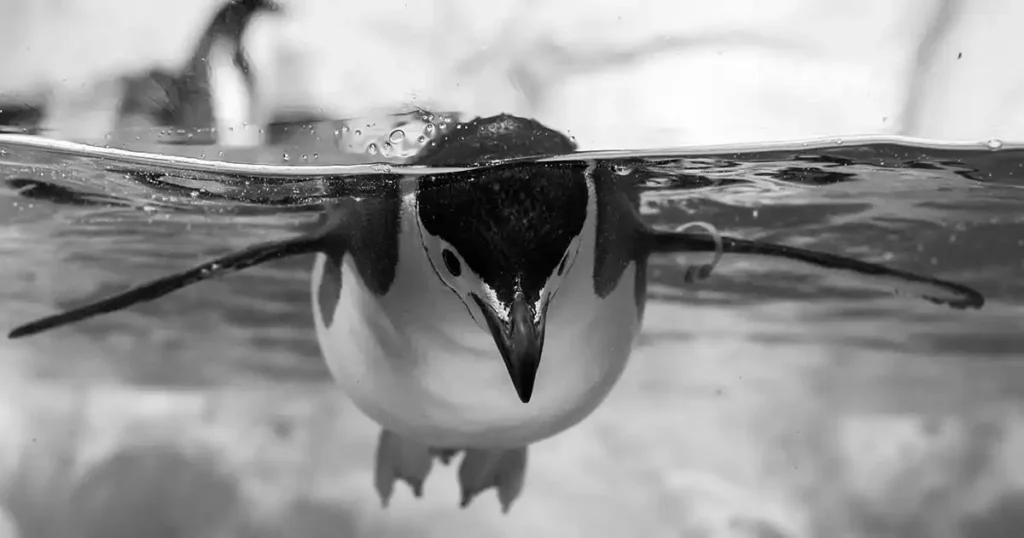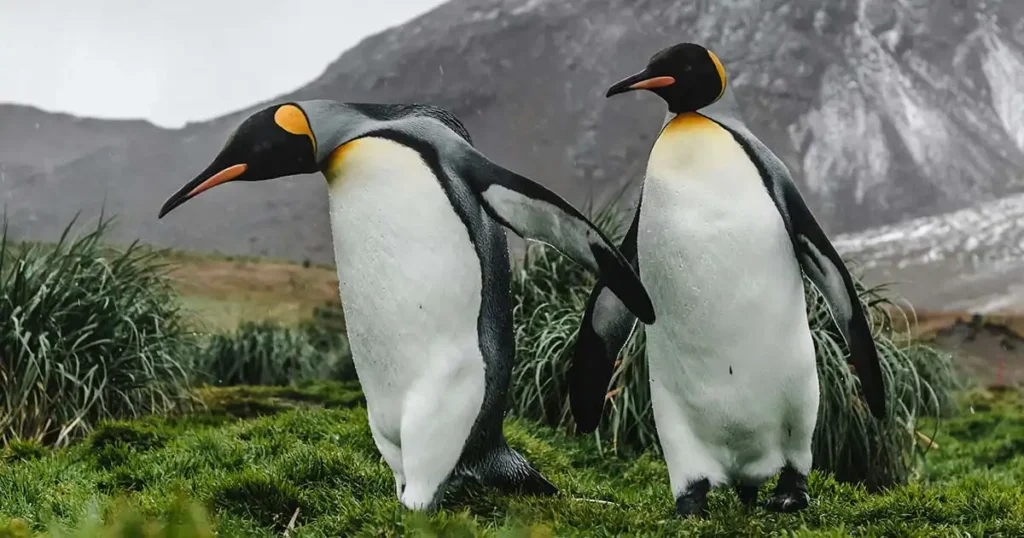Dive into the fascinating world of our tuxedoed friends with our curated collection of interesting facts about Penguins. These charismatic birds, known for their playful waddle and sleek black-and-white attire, hold a plethora of captivating secrets.
From their remarkable underwater acrobatics to heartwarming family dynamics, this article unveils 20 intriguing facts that showcase the incredible lives of penguins.
Join us on a journey to discover the hidden wonders of these feathered inhabitants of both icy polar realms and sun-kissed coastal paradises.
Get ready to be amazed by the unique and sometimes surprising features that make penguins some of the most enchanting creatures on our planet.
20 Interesting Facts about Penguins
1. Penguins can’t fly, But They’re Amazing Swimmers

Penguins can’t fly, but they’re amazing swimmers. Their wings have turned into flippers, making them a bit awkward on land, but super fast underwater. When they swim, they’re so skilled at moving around that it looks like they’re flying through the water, just like a bird soaring in the air.
2. Penguins are Deep Sea Divers
Penguins are really fast swimmers and excellent deep-sea divers. When they dive into the water, they can zip along at speeds of up to 12 kilometers per hour, and some can even reach an impressive 27 km/h. The bigger penguins can dive deep, like Emperor Penguins, who can go down to 565 meters below the surface and stay submerged for as long as 22 minutes. That’s pretty amazing!
3. Penguins Have Clever Ways to Get Around on Land
Penguins have clever ways to get around on land, even though their body shape and short legs could make it tricky. They use a move called tobogganing, where they slide on their bellies across the snow. When they’re standing, penguins either waddle on their feet or take jumps with both feet together to move around different terrains. It’s like they have their special moves for walking and sliding!
4. There are 17-20 Penguin Species
While the exact number isn’t certain, there are quite a few penguin species. Most people think there are somewhere between 17 to 20 different types of penguins in the world. These adorable birds come in various shapes and sizes, making each species unique in its way.
5. Penguins Use of a Layer of Air
Penguins make good use of a layer of air for different advantages. When they’re underwater, the smooth feathers of the penguin trap a layer of air. This trapped air helps them stay afloat, acting like a natural life jacket. Additionally, the air layer works as insulation, keeping the penguin warm when swimming in chilly waters. It’s like having their built-in protection system!
6. Penguins Find their Food Underwater
Penguins find their food by diving underwater. Even though it might seem like they’re just having fun, penguins are hunting for sea life while swimming. They spend a significant amount of time in the water because that’s where they get their meals. For instance, the Gentoo Penguin, a particular type of penguin, can make up to 450 dives in a single day when they’re out looking for food. They’re like underwater experts on a constant mission for their next meal!
7. Penguins have Unique Vision Designed for Underwater Adventures
Penguins have a unique vision designed for underwater adventures. Their eyes come with special adaptations that give them excellent vision beneath the water. This special eyesight helps them find food and keep an eye out for potential predators in their underwater world. It’s like having built-in goggles to navigate and explore their marine surroundings.
8. Penguins are Highly Social
Penguins are very social creatures. Since they live in big groups called colonies, they have lots of chances to interact with each other. To communicate in these bustling communities, penguins have developed various ways to signal each other. They use both sounds and visual cues, creating a lively social environment where they can stay connected and cooperate with their fellow penguins.
9. Penguins have Large Extended Families
Penguins form big, extended families when they breed. For example, Gentoo Penguin colonies may have around 100 pairs, while some other penguin species gather in colossal colonies with several hundreds of thousands of penguins. It’s like a massive family reunion where penguins come together to raise their chicks and support each other in their colonies.
10. Penguins Usually have Small Families
Penguins usually have small families. Most penguins lay two eggs in a clutch, but the King and Emperor penguins, which are the largest penguin species, have just one egg in a clutch. Interestingly, when you consider the size of the adult penguin, these birds lay the smallest eggs compared to any other bird species on Earth. It’s a small family affair for penguins!
11. Penguins Believe in Teamwork
Penguins understand the importance of teamwork. In tough weather, they huddle together to stay warm and save energy. They have a smart rotation system – when a penguin in the middle warms up, it moves to the outside, making room for another chilly penguin to take its turn in the cozy center. It’s like they’ve figured out a way to share the warmth and take care of each other in their tight-knit penguin community.
12. Monogamy is Pretty Common in Penguin

In the penguin world, monogamy is pretty common. During the breeding season, penguin pairs stick together. After the chicks have hatched and grown enough to fend for themselves, some couples choose to stay together, while others may go their separate ways. It’s a bit like the penguin version of relationships – some stick together for the long haul, and others might part ways once their little ones can manage on their own.
13. Homosexuality is a Natural Part of Penguin
Homosexuality is a natural part of penguin culture. Penguins are known for having widely publicized homosexual relationships, making them stand out in the animal kingdom. It’s a unique aspect of penguin behaviour that shows diversity in their social structures and relationships.
14. Almost All Penguin Species Share the Job of Incubating Eggs
Almost all penguin species share the job of incubating eggs, with about 99.999% of them dividing the duties equally between males and females. Both parents take on the responsibility of caring for the eggs and their young. However, there is one exception to this rule: the male Emperor Penguin doesn’t participate in incubating the eggs; instead, the female takes on this task alone. It’s a unique aspect of penguin parenting!
15. Most Male Penguins Help with Incubation Shifts
It’s a good thing that most male penguins help with incubation shifts. When one partner goes to the sea to feed, the other stays behind to take care of the incubating egg. Sometimes these shifts can last for days or even months, especially if the ice pack forms, creating an open ocean up to 80 kilometers away from the colony. The teamwork ensures that the eggs are well cared for, even in challenging conditions.
16. Penguins have Amazing Hearing Abilities
Penguins have amazing hearing abilities. Their sensitive ears help parents and chicks find each other amid a crowded penguin colony. It’s like having a natural navigation system that allows them to stay connected with their family in the hustle and bustle of their colony.
17. Penguins have a Built-In Camouflage
Penguins come with their camouflage. The color pattern of their feathers, with black on their backs and white on their fronts, acts as a form of camouflage. This makes it hard for predators below to spot them while swimming, as the black blends in with the dark ocean when viewed from above. It’s like a natural disguise that helps them stay hidden and safe in the water.
18. Penguins Have No Land Predators
Penguins are protected from land predators when they’re on land. They don’t have any natural enemies on land, which is why they often show little fear of humans. This lack of fear has allowed researchers to study these fascinating birds up close without much disruption, contributing to our understanding of penguins and their behavior.
19. You Can Figure Out Where Penguins are From Based on their Size
You can figure out where penguins are from based on their size. The bigger penguin species prefer colder climates, while the smaller ones are usually found in warmer areas of the world. It’s like their size is a clue about the kind of environment they call home.
20. Penguins Spend Their Time Equally on Land and Water
Most penguins split their time equally between land and water. They spend about half of their lives on land and the other half in the water. They’re like expert multitaskers, balancing their activities on both land and sea.
You may also like:
Wrapping Up
As we conclude our exploration of Interesting Facts about Penguins, we are left with a deeper appreciation for these remarkable birds that inhabit both the frosty Antarctic landscapes and the sunlit shores of distant islands.
From their exceptional swimming abilities and family dynamics to their adaptability to diverse climates, penguins stand out as resilient and captivating creatures.
Their endearing behaviors, unique features, and the delicate balance they maintain in their ecosystems make them true wonders of the avian world. As we continue to marvel at the intriguing facts shared in this journey, one cannot help but feel a sense of admiration for these feathered waddlers and their extraordinary lives.
So, whether you’re a seasoned penguin enthusiast or a curious newcomer, these facts have hopefully sparked a newfound curiosity and respect for the incredible world of penguins.



GIPHY App Key not set. Please check settings